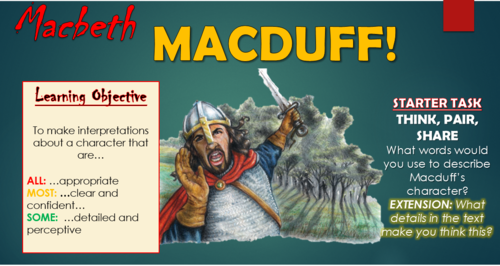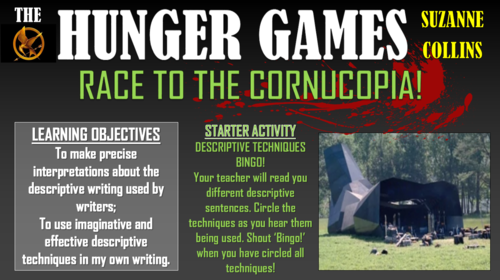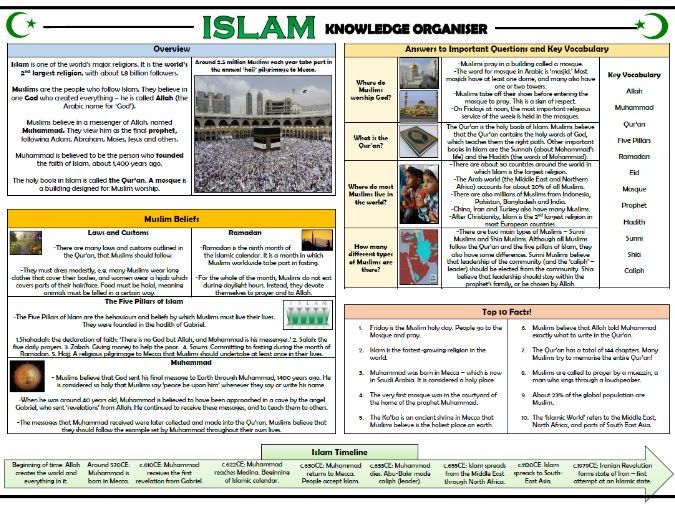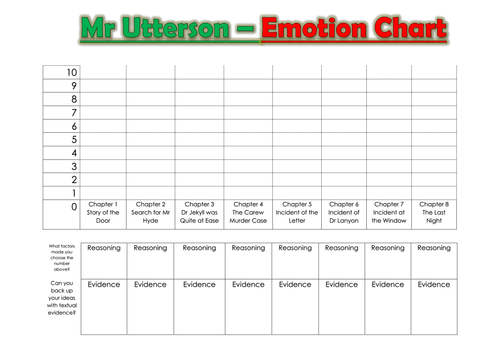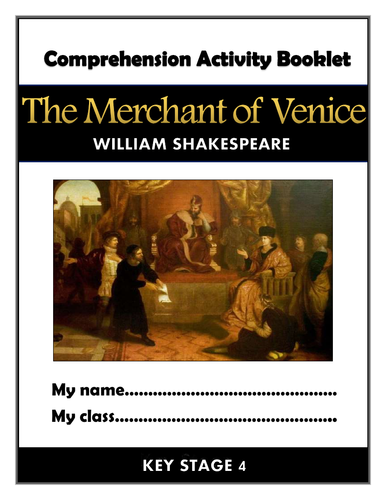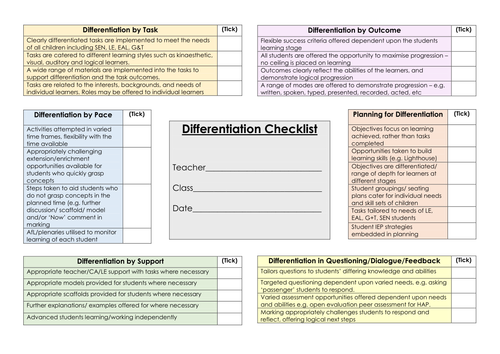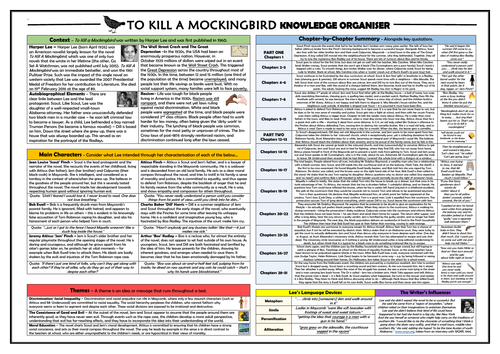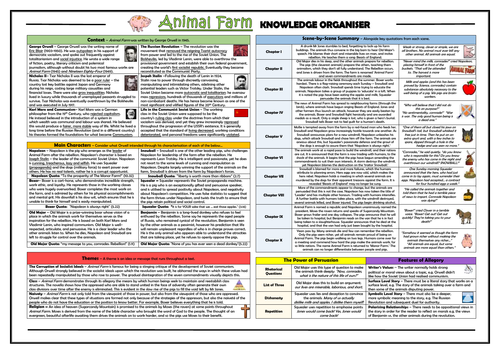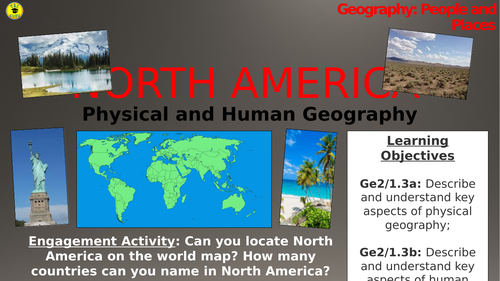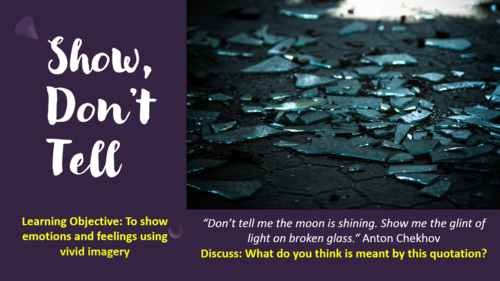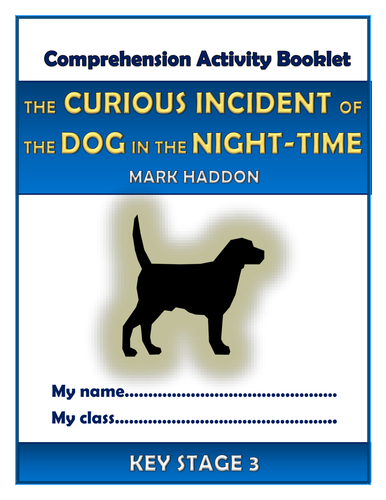
3k+Uploads
1880k+Views
2219k+Downloads
All resources

Macbeth: Macduff!
This engaging and interesting lesson aims to improve students’ understanding of one of the key characters in William Shakespeare’s Macbeth: Macduff. In particular, they learn to make insightful interpretations about the character, and are enabled to to infer and deduce Macduff’s key characteristics from his involvement at particular moments in the play, in addition to considering how Shakespeare deploys Macduff as a fitting hero to face Macbeth’s tyranny.
The lesson utilises a range of tasks, that require students to be visual and interactive learners. It follows this learning journey:
Inferring key information about the character of Macduff from events in the text;
Identifying and ordering the key events in the text in which Macduff is involved;
Understanding his role in the downfall of Macbeth;
Understanding his character in relation to historical context, considering Shakespeare’s intentions through the character;
Analysing Shakespeare’s development of Macduff as a key character throughout the text;
Evaluating the learning in the lesson.
Included in this resource pack are:
A well-presented, thorough, and informative, whole-lesson PowerPoint presentation;
Resources for the card sorting sequencing activity, detailing Macduff’s numerous actions throughout the play;
A Macbeth vs Macduff worksheet, to enable students to understand Macduff’s heroic characteristics;
A template to help scaffold the main task, complete with P.E.E instructions;
A comprehensive teacher guidance form/lesson plan to assist delivery.
All images in this resource are licensed for commercial use, and are cited on the final slide of the lesson presentation.
Bundle Sale

Holes Huge Bundle!
THIS BUNDLE CONTAINS ALL OF THE HOLES LESSONS, IN ADDITION TO THE COMPREHENSION BOOKLET, THE KNOWLEDGE ORGANISER AND THE POINTLESS GAME!
This engaging, varied, and informative scheme of learning is designed to help students gain understanding, assessment skills, and key interpretations of Louis Sachar's 'Holes.' Made up of a wide-range of interesting and exciting lessons, students should complete this scheme having gathered vital skills in: interpreting the significant meanings of the text, understanding the writer's ideas within the text, identifying the traits of key characters, settings, and themes, understanding dramatic and language devices, and relating the text to its social and historical context.
Stimulating, visual, and easily adaptable, these lessons provide suggested learning objectives and outcomes for students of a wide-range of abilities - The vast majority of tasks are differentiated to allow for different abilities and needs in your classroom. Each lesson loosely follows this logical learning journey to ensure that students learn in bite-size steps:
- Engaging
- Defining/ Understanding
- Identifying/Remembering
- Analysing/ Creating
- Peer or self evaluating.
All of the lessons are interactive, employ a variety of different teaching and learning methods and styles, and are visually-engaging. Resources, worksheets, and lesson plans are all provided.
Bundle Sale

The Hunger Games Huge Bundle!
THIS BUNDLE CONTAINS ALL OF THE HUNGE GAMES LESSONS, IN ADDITION TO BOTH OF THE COMPREHENSION BOOKLETS, THE KNOWLEDGE ORGANISER AND THE POINTLESS GAME!
This engaging, varied, and informative scheme of learning is designed to help students gain understanding, assessment skills, and key interpretations of Suzanne Collins’ ‘The Hunger Games.’ Made up of a wide-range of interesting and exciting lessons, students should complete this scheme having gathered vital skills in: interpreting the significant meanings of the text, understanding the writer’s ideas within the text, identifying the traits of key characters, settings, and themes, understanding dramatic and language devices, and relating the text to its social and historical context.
Stimulating, visual, and easily adaptable, these lessons provide suggested learning objectives and outcomes for students of a wide-range of abilities - The vast majority of tasks are differentiated to allow for different abilities and needs in your classroom. Each lesson loosely follows this logical learning journey to ensure that students learn in bite-size steps:
Engaging
Defining/ Understanding
Identifying/Remembering
Analysing/ Creating
Peer or self evaluating.
All of the lessons are interactive, employ a variety of different teaching and learning methods and styles, and are visually-engaging. Resources, worksheets, and lesson plans are all provided.

KS1 RE - My Special Places!
In this engaging lesson, students consider the places that are important to them. The lesson serves as a foundation for children’s later learning about places that are special to people of different faiths.
The learning is guided by a clear and colourful PowerPoint presentation, which guides students through the following step-by-step journey:
-Discussing the differences between a house and a home;
-Considering what features make a home a special place to many people;
-Identifying the things that make their own homes a special place;
-Brainstorming other places that people may consider as special, e.g. their town or their school;
-Understanding that different people are individuals, and have their own opinions of places that are special;
-Completing a plenary activity to assess their understanding;
-Self-reflecting on the extent to which they feel they have met the learning objective.
This resource pack includes the comprehensive PowerPoint presentation (17 slides) and the template for the main special places activity (provided in Word and PDF). There is everything that you need here to teach the lesson.
In the past, I have used this lesson with children from across Key Stage 1 - the key learning is aligned with curriculum expectations for RE, and also the content prescribed by most diocese regions. All images are licensed for commercial use.

The Hunger Games - Race to the Cornucopia! (Descriptive Writing Lesson)
This engaging and informative lesson enables students to compose sophisticated, imaginative creative writing, through producing a first person account about competing in the opening stages of The Hunger Games. In order to do so, students first analyse the descriptive writing devices and sentence structures used by Suzanne Collins in Chapter 11 of The Hunger Games - the section in which the Hunger Games commence – before applying what they have learnt to their own compositions.
The lesson follows a step-by-step learning journey, in which children learn through:
Defining each of the different types of descriptive devices, through playing a fun, interactive bingo game;
Reading an extract from Chapter 11 of the text (provided) which describes the moments immediately before and after the Hunger Games commence;
Identifying the language techniques used in the extract to paint an image of place in the minds of the readers, and to create the desired atmosphere;
Analysing the effectiveness of each of Collins’ descriptive devices;
Analysing the sentence structures and lengths employed by Collins in the extract;
Creating their own first-person description of the horrific moments at the Cornucopia, before and after the Hunger Games begin;
Peer assessing each other’s learning attempts.
Included is:
Whole lesson PowerPoint - colourful and comprehensive;
Bingo Cards for the starter activity (and host instructions/ questions);’
Extract from Chapter 11 of The Hunger Games;
Structure strips to support the descriptive writing;
Writing to Describe Helpsheet to support the descriptive writing;
Comprehensive Lesson Plan.
All resources are provided in Word (for easy editing) and PDF (to ensure formatting remains fixed between different computers).
There are also opportunities for group learning, speaking and listening, peer assessment, and whole class discussion. I originally used these resources with year 8 classes, however colleagues have used them for between years 5 and 10 with some adaptations.
All images are licensed for commercial use, and image rights are listed on the last page of the presentation.

Islam Knowledge Organiser!
This detailed and visually-appealing resource offers a complete reference point for students learning about/ revising their understanding of Islam. It contains comprehensive sections under the following headings:
-Islam Overview;
-Islamic Beliefs;
-Islam Timeline;
-Key Vocabulary;
-Top Ten Facts;
-Answers to the Important Questions.
Key words and ideas are underlined for easy reference. The resource is designed to be printed onto A3, and is provided as both a PDF and a Word version (so that you can edit if you want to).
Bundle Sale

Teaching and Learning CPD Bundle!
These teaching and learning CPD sessions offer engaging and original approaches to introducing or revisiting a range of effective pedagogical strategies. Grounded in educational research, these sessions are interactive, well-structured, and have been successfully tried and tested.
The aim of each teaching and learning CPD session is to develop the knowledge, skills, and strategies needed in order to utilise in practice in each key area, and as an aid in achieving these aims, the trainer is supported with:
-Colourful, engaging, and comprehensive PowerPoint presentations;
-Videos for analysis of key techniques;
-A wide range of interactive resources for CPD activities;
-Instructions and plans to assist delivery.
All images and videos are licensed for commercial use, and are cited on the final slide of each PowerPoint.

Dr Jekyll and Mr Hyde: Mr Utterson!
This engaging and informative lesson enables students to make sustained and insightful interpretations of the way in which the character of Utterson is presented and developed throughout ‘Strange Case of Dr Jekyll and Mr Hyde.’ In particular, students analyse how the Utterson’s calm and rational demeanour is tested through the strange and tragic events in the novella.
The lesson follows a step-by-step learning journey, in which children learn through:
- Establishing how the key characteristics of Mr Utterson;
- Reading and comprehending key extracts describing Mr Utterson in the text;
- Analysing how Utterson's character is developed through events in the text;
- Empathising with Utterson's character and establishing his viewpoints;
- Peer assessing each other's learning attempts.
Included is:
- Whole lesson PowerPoint - colourful and comprehensive;
- Selected extracts from the text describing Utterson;
- Utterson Emotion Graph for the development task;
- Analysis template with success criteria for creating well-structured responses;
- Comprehensive lesson plan.
There are also opportunities for group learning, peer assessment, and whole class discussion. These resources were originally taught to GCSE students, but with subtle adaptations they have also been used with KS3 and A Level Students.
All images are licensed for commercial use, and image rights are listed on the last page of the presentation.

The Big Enterprise Project!
This engaging investigation activity allows students to use develop their innovation, creativity and collaboration skills to control the direction of their enterprise project.
The resource set guides students through the entire project, from conception to evaluation, and includes resources/ guidance for the following activities:
-Deciding upon different roles within their groups, in order to carry out multiple tasks effectively;
-Designing a company name and appropriate logo and slogan;
-Researching their product area, including competitors and USPs;
-Conducting market research;
-Budgeting;
-Detailed product design;
-Packaging design;
-Creating instructions for users;
-Formulating and presenting a persuasive pitch;
-Surveying the target audience for their feedback;
-Self-evaluating strengths and areas for development.
A comprehensive PowerPoint presentation guides students through the project.
There are at least a week’s worth of resources in here, enabling students to fully immerse themselves in the project. I orignally have used this with KS2 and KS3 students, but they could reasonably be adapted for students in KS4.
All images have been cited at the end of the PowerPoint presentation and are licensed for commercial use.

The Merchant of Venice Comprehension Activities Booklet!
This resource booklet contains a wide range of age-appropriate, engaging, and meaningful comprehension activities for use throughout the reading of William Shakespeare’s ‘The Merchant of Venice.’ Teachers have found them particularly useful in exam revision, comprehension tasks, or guided reading sessions. They are perfect for aiding the progress of students towards meeting the KS4 expectations within the new National Curriculum framework - this makes the tasks suitable for all examining bodies. Students have found these resources extremely engaging, and for teachers there is explicit information within each task regarding which comprehension strands the task is designed to demonstrate. They also relate to key extracts, characters, and themes from the play ensuring that students gain a deep understanding of the text.
Activities within the booklet include:
‘Context: Shakespearean Times’ - to aid students with ‘Drawing on knowledge of the purpose, audience and context of the writing, including its social, historical and cultural context and the literary tradition to which it belongs, to inform evaluation;’
‘Shakespeare’s Description’ - to aid students with ‘Analysing a writer’s choice of vocabulary, form, grammatical and structural features, and evaluating their effectiveness and impact;’
‘Shylock’ and ‘Bassanio’ character profiles- to aid students with ‘Seeking evidence in the text to support a point of view, including justifying inferences with evidence;’
‘Editing the Play’ - to aid students with ‘Making an informed personal response, recognising that other responses to a text are possible and evaluating these.’
Plus many, many more activities (the booklet is around 30 pages in length!) I’ve also added it as a PDF in case the formatting differs on your computer.
All images are licensed for commercial use, and are cited on a separate document (included).

Learning Walk/ Teacher Development Checklists
These comprehensive checklists have been created to aid school leaders when performing learning walks with a particular focus e.g. questioning, differentiation, etc. Clearly structured and organised, they present a central idea surrounded by a breakdown of a number of its key components.
For the user, this layout provides a simple reference list of each of the desirable skills, categorised appropriately. The checklists also provide an alternative to regular feedback methods, which often focus too heavily on the standard or ‘judgement’, as opposed to being a developmental tool.
Alternatively, these are really handy for teachers looking to develop their practice in the key teaching areas listed below. Included in the pack are checklists for:
-Questioning
-Differentiation
-Utilising Resources (including support staff)
-Engagement
-Building Literacy Skills
-Planning and Expectations
-Building Learning Power
-A blank template for you to design your own based upon your own focus
Note: The checklists offer a range of desirable strategies that teachers should look to implement over time - it would be damaging to expect teachers to utilise each of these strategies in every lesson!
Many Thanks
Bundle Sale

War Horse Big Bundle!
THIS BUNDLE CONTAINS ALL OF THE WAR HORSE LESSONS, IN ADDITION TO THE COMPREHENSION BOOKLET, THE KNOWLEDGE ORGANISER AND THE POINTLESS GAME!
This engaging, varied, and informative scheme of learning is designed to help students gain understanding, assessment skills, and key interpretations of Michael Morpurgo’s’ ‘War Horse.’ Made up of a wide-range of interesting and exciting lessons, students should complete this scheme having gathered vital skills in: interpreting the significant meanings of the text, understanding the writer’s ideas within the text, identifying the traits of key characters, settings, and themes, understanding dramatic and language devices, and relating the text to its social and historical context.
Stimulating, visual, and easily adaptable, these lessons provide suggested learning objectives and outcomes for students of a wide-range of abilities - The vast majority of tasks are differentiated to allow for different abilities and needs in your classroom. Each lesson loosely follows this logical learning journey to ensure that students learn in bite-size steps:
Engaging
Defining/ Understanding
Identifying/Remembering
Analysing/ Creating
Peer or self evaluating.
All of the lessons are interactive, employ a variety of different teaching and learning methods and styles, and are visually-engaging. Activity resources, worksheets, and lesson plans are all provided.

The Sign of Four Knowledge Organiser/ Revision Mat!
This detailed and visually-appealing resource offers a complete reference point for students learning or revising Arthur Conan Doyle's 'The Sign of Four.' It contains comprehensive sections on:
- Context;
- Chapter by Chapter Summary (with quotes);
- Main Characters;
- Themes;
- Doyle's Language Devices;
- Features of Detective Novels.
Key words and ideas are underlined for easy reference. The resource is designed to be printed onto A3, and is provided as both a PDF and a Word version (so that you can edit if you want to). All images used are licensed for commercial use and are cited on a separate document (included).

To Kill a Mockingbird Knowledge Organiser/ Revision Mat!
This detailed and visually-appealing resource offers a complete reference point for students learning or revising Harper Lee’s ‘To Kill a Mockingbird.’ It contains comprehensive sections on:
Context;
Chapter by Chapter Summary (with quotes);
Main Characters;
Themes;
Lee’s Language Devices;
Influences on the Writer.
Key words and ideas are underlined for easy reference. The resource is designed to be printed onto A3, and is provided as both a PDF and a Word version (so that you can edit if you want to). All images used are licensed for commercial use and are cited on a separate document (included).

Simple, Compound and Complex Sentences!
This detailed and engaging lesson enables students to gain an understanding of simple, compound and complex sentences, and to use a variation of sentence types in their own writing for clarity and effect.
Students learn through a number of fun and interactive tasks, which enable them to:
- Define and exemplify simple, compound, and complex sentences;
- Identify them in writing;
- Understand and analyse how different types of sentences can be used for clarity and effect;
- Create a written piece using a variety of sentence structures for clarity and effect;
- Evaluate their use of different sentence structures.
The resources include:
-Visually engaging and comprehensive whole-lesson presentation;
-Resources for the card-sorting activity;
-A model example and analysis worksheet;
-A success criteria;
-Step-by-step lesson plan.
All images are licensed for commercial use, and are cited on the final page of the slide.

Animal Farm Knowledge Organiser/ Revision Mat!
This detailed and visually-appealing resource offers a complete reference point for students learning or revising George Orwell's 'Animal Farm.' It contains comprehensive sections on:
- Context;
- Chapter by Chapter Summary (with quotes);
- Main Characters;
- Themes;
- Features of Allegory;
- 'The Power of Persuasion (in the speeches of Old Major and Squealer).
Key words and ideas are underlined for easy reference. The resource is designed to be printed onto A3, and is provided as both a PDF and a Word version (so that you can edit if you want to). All images used are licensed for commercial use and are cited on a separate document (included).

North America: Physical and Human Geography (People and Places)
This interesting and highly-stimulating lesson enables students to describe and understand the key aspects of physical geography (e.g. climates, vegetation belts, flora, fauna, mountains, and rivers) and human geography (e.g. types of settlement, populations, use of resources, and trade) in the vast and varied continent of North America. Whilst gaining a wide range of knowledge about the content, students also become familiar with a wide range of vocabulary pertinent to the geography curriculum.
The lesson follows a clear, logical, bite-size learning journey, which guides students towards relevant and constructive learning objectives. Over the course of this journey, they become able to:
Identify North America on a map, and identify the countries and regions within the continent;
Understand key information about the physical and human geography of the continent, through a fun, interactive quiz;
Retrieve, share, and describe their understanding of the physical and human geography of specific locations in North America (Mexico City, Death Valley, The Canadian Shield and the Caribbean Islands) through a jigsaw model task;
Complete a case study of the physical and human geography of their own place in North America, and describe their findings to others;
-Peer assess each other’s descriptions using the learning objectives.
This resource pack includes:
A visually engaging whole-lesson PowerPoint presentation;
Key case-study information sheets on Mexico City, Death Valley, The Canadian Shield and the Caribbean Islands (in both PDF and Word - inside the zip-folder);
A blank case study template.
All images are licensed for commercial use. Note: The final task works best with access to ICT/internet resources.
This resources within this lesson can be easily adapted to suit home/remote learning.

Show, Don't Tell - Writing About Emotions!
This engaging and highly-purposeful lesson enables children to write about emotions and feelings using vivid imagery.
Children learn how to show, not tell in their writing, focusing on precise details relating the senses. This helps to make their writing more immersive - painting an image in the mind of the reader with their words.
Children learn through:
-Defining and understanding what is meant by showing, not telling;
-Considering how each of the major emotions/ feelings can be shown;
-Turning their ‘showing’ simple sentences into compound and complex sentences;
-Editing and enhancing their showing sentences through consideration of precise verbs, adverbs and the use of analogies.
Provided in this resource pack are:
-Colourful and comprehensive PowerPoint presentation, offering a step-by-step guide through the lesson;
-Showing Emotions table template;
-Showing Emotions helpsheet (for LAP students).
The worksheets/ templates are provided as Word (for ease of editing) and PDF (to prevent formatting issues between devices).
The lesson was originally created for children in upper KS2, however with minor adaptations could easily be suitable for those in lower KS2 or lower KS3.
Bundle Sale

The Tempest Huge Bundle!
THIS BUNDLE CONTAINS ALL OF THE TEMPEST LESSONS, IN ADDITION TO THE COMPREHENSION ACTIVITY BOOKLET, THE TEMPEST KNOWLEDGE ORGANISER, AND THE POINTLESS GAME!
This engaging, varied, and informative scheme of learning is designed to help students gain understanding, assessment skills, and key interpretations of William Shakespeare’s ‘The Tempest.’ Made up of a wide-range of interesting and exciting lessons, students should complete this scheme having gathered vital skills in: interpreting the significant meanings of the play, understanding the writer’s ideas within the play, analysing key characters, settings, and themes, and understanding Shakespeare’s language devices.
Stimulating, visual, and easily adaptable, these lessons provide suggested learning objectives and outcomes for students of a wide-range of abilities - The vast majority of tasks are differentiated to allow for different abilities and needs in your classroom. Each lesson loosely follows this logical learning journey to ensure that students learn in bite-size steps:
Engaging
Defining/ Understanding
Identifying/Remembering
Analysing/ Creating
Peer or self evaluating.
All of the lessons are interactive, employ a variety of different teaching and learning methods and styles, and are visually-engaging. Resources, worksheets, and lesson plans are all provided.

The Curious Incident of the Dog in the Night-time KS3 Comprehension Activities Booklet!
This resource booklet contains a wide range of age-appropriate, engaging, and meaningful comprehension activities for use throughout the reading of Mark Haddon's 'The Curious Incident of the Dog in the Night-time.' Teachers have found them particularly useful in comprehension or guided reading sessions. They are perfect for aiding the progress of children towards meeting the KS3 expectations within the new National Curriculum framework. Children have found these resources extremely engaging, and for teachers there is explicit information within each task regarding which comprehension strands the task is designed to demonstrate. They also relate to key extracts, characters, and themes from the story, ensuring that children gain a deep understanding of the text.
Activities within the booklet include:
- 'Context: Asperger's Syndrome' - to enable students to demonstrate that they can: 'Know the purpose, audience and context of the writing and drawing on this knowledge to support comprehension.'
- 'Haddon's Description - The Police Station' - to enable students to demonstrate that they can: 'Know how language, including figurative language, vocabulary choice, grammar, text structure and organisational features, present meaning.'
- 'Ed Boone' - to enable students to demonstrate that they can: 'Study setting, plot, and characterisation, and the effects of these.'
- 'Vocabulary Inspector' - to enable students to demonstrate that they can: 'Learn new vocabulary, relating it explicitly to known vocabulary and understanding it with the help of context and dictionaries.'
Plus many, many more activities (the booklet is 21 pages in length!) I've also added it as a PDF in case the formatting differs on your computer.
All images are licensed for commercial use, and are cited on a separate document (included).

